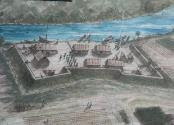 |
| Mrs. Caroline Slemmer |
When state forces from Florida and Alabama had occupied Fort Barrancas, Fort McRee and the Pensacola Navy Yard in January of 1861, a number of the wives and children of soldiers were present. These, along with U.S. servicemen taken prisoner and paroled and other noncombatants, went aboard the storeship U.S.S.
Supply. The vessel made its way out of Pensacola Harbor and set sail, arriving in New York 150 years ago today.
Aboard the
Supply were the wives of Lieutenants Adam J. Slemmer and J.H. Gilman, the two principal officers now commanding the besieged garrison of fewer than 100 U.S. soldiers and sailors at Fort Pickens. They provided to northern newspapers a unique account of the situation at Pensacola as it had been when they left the harbor in January:
Statements of Mrs. Slemmer and Mrs. Gilman.
Mrs. Lieutenant Slemmer and Mrs. Lieut. J.H. Gilman, two ladies who have arrived at New York in the Supply, from Pensacola, have furnished the Times with some particulars attending their departure from that place. We quote:
The exodus from the Barrancas Fort was made necessarily in much haste, there being little time except to hurriedly pack up the most valuable articles of furniture and wardrobe. No personal violence was offered to three retreating women and children, but the sudden and peaceable breaking up of so many peaceful households, and the violent separation of family ties, were cause of great distress. To many the parting of husband and wife was as if for the last time, and tears bedewed many a hardy cheek when the last “good-bye” was spoken.
 |
| Fort Barrancas |
During the day and night of the evacuation of Barrancas, and the transfer of the garrison to Fort Pickens, every person – men, the officers and their wives – performed prodigies of labor, and never obtained a wink of sleep for nearly twenty-four hours; and the hard work fell about equally upon all, without regard to rank or sex. The ladies cheerfully performed their part throughout the trying ordeal. On the day following the embarkation of the families on board the Supply, Mrs. Gilman and Mrs. Slemmer, accompanied by officers from the storeship, went on shore under a flag of truce to obtain a last interview with their husbands.
Lieut. Slemmer asserted that he could hold the place against five thousand men, and declared he would do it.
All the prisoners in the navy-yard were permitted to leave after giving their parole, and those who could get away left. Such as decided to remain were compelled to take the oath of allegiance to serve the State of Florida.
The United States steamer Wyandotte is kept constantly under steam, at a safe distance from the reach of enemies, and in readiness to co-operate in the defense of the fort. In case of an emergency she will be at hand ready to receive on board the garrison, should they be overpowered and obliged to abandon the fort to the enemy. There are arrangements by which the entire forces will be able to escape through a covered way to the beach, where they can take the boats and go on board any vessel that may be in waiting to receive them. In such event it will probably be blown up.
It is stated that every one of the lieutenants and most of the other officers on board the Wyandotte have resigned, and that with the exception of the engineers, Capt. Berryman has been left entirely alone. - Pittsfield Sun, February 6, 1861.




